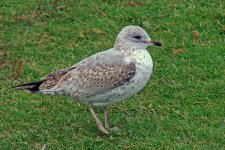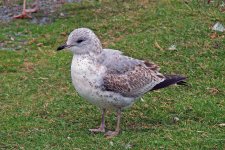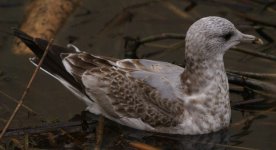I dont think its clever to tackle the ID of this gull from an european point of view.
This gull would clearly stand out in a flock of Common Gulls in Europe by the following points:
round, stocky appearance with short, plump, short-winged rear end
slightly thicker bill than normal with parallel edges (but I think still within the variation of canus. I have seen Common Gulls with stronger bills before, but everytime I thought this might be a Ring billed Gull it turned out to be a Common Gull. So this might be on more example of this)
unusual hazel brown colour of the wing coverts and the shape of the dark centers
barring on the undertailcoverts (Common Gull with markings there have a different pattern)
While it is true that most first winter canus in western Europe have a uniform grey mantel, the situation in NE Germany (Baltic coast and near the polish boarder) is slightly different: many birds there lack this uniformity as they show retained juvenile feathers and/or first winter feathers with dark markings or paler edges (last ones mentioned as heinei-characters by Peter Adriaens and Chris Gibbins in their Dutch Birding paper)
See for example this bird, a possible heinei, taken in Prenzlau:
https://www.ornitho.lu/index.php?m_id=54&mid=357250 or
https://flic.kr/s/aHskqnP6AA, or the attached bird, taken in Schwedt/Oder.
Would I say that this bird is a Ring Billed Gull? No, I havent seen this species or the other relevant taxa Short-billed Gull or kamtschatschensis.
I just wanted to say that this bird would look (slightly) odd for a nominate canus Common Gull.
I also think that Nutcracker is right regarding the darkness of the mantel. In this respect, this bird wouldnt stand out in a flock of canus in Europe.
I assume that you dont have pictures of this bird showing the tail pattern more clearly?






